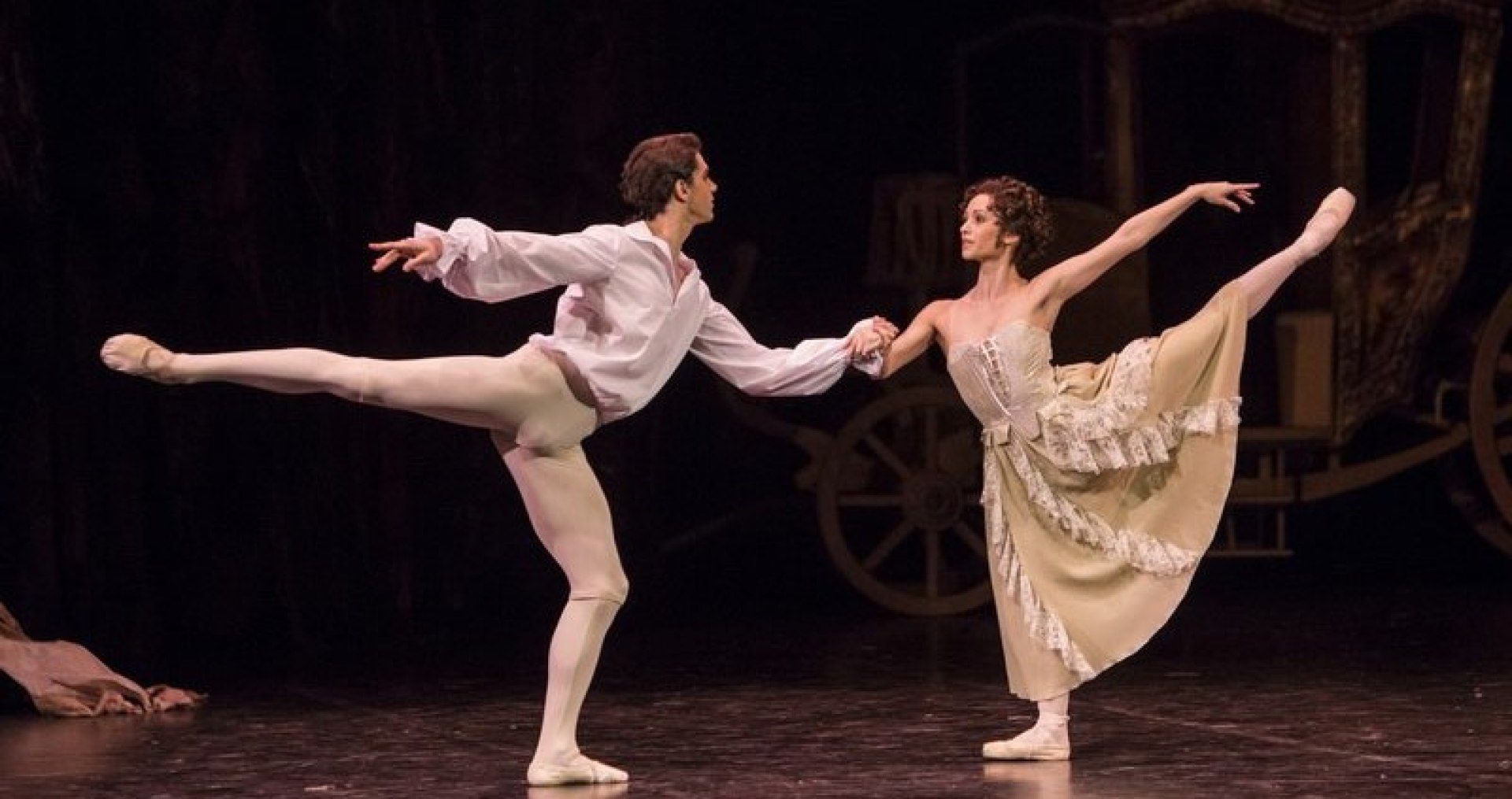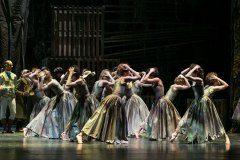Manon
Mo | Tu | We | Th | Fr | Sa | Su |
MANON | Sir Kenneth MacMillan / Jules Massenet – Martin Yates
Ballet in three acts
Performance length: 3 hours, with 2 intermissions.
During his career, Sir Kenneth MacMillan managed to reinvent not just the language of ballet, but also its subject matter: on many occasions he reached for modern, socially and societally charged themes that no one had ever dared to touch in any genre, let alone in dance. He was met with this criticism also after the 1974 premiere of Manon: even though it won enormous acclaim from audiences, critics were shocked by an immoral plotline that was completely unprecedented in the world of classical ballet at the time. Leighton Lucas created the score of the ballet based on Massenet’s works: although using nothing from Manon itself, he compiled the musical material from the composer’s many other operas and oratorios, which Martin Yates later re-orchestrated in 2011. Manon is performed with MacMillan’s original scenery and costumes on the stage of the Opera House.
Synopsis
Act I
Scene 1 – The courtyard of an inn near Paris
Various gentlemen and actresses and ladies of the demimonde can be seen in the yard. Among them are the Chevalier Des Grieux, a young student, as well as the wealthy Monsieur G. M. and a certain Lescaut, the latter who is there to meet his sister, Manon, before she enters the convent. A coach arrives, and Manon and her elderly companion get out. The old gentleman seems to be attracted to the pretty young girl. Lescaut notices his attraction and invites his sister’s aged geriatric gallant to the inn so that they can discuss her future. Manon, who remains outside, glimpses Des Grieux, and they fall in love with each other immediately. They decide to escape to Paris with the help of the money that Manon has stolen from the old gentleman. Having struck a deal, Monsieur G. M. and Lescaut come out of the in and are shocked to find that Manon has disappeared. Monsieur G. M. tells Lescaut that he is very much interested in Manon, and because Monsieur G. M. is wealthy, Lescaut promises to find his sister and say a few words in the old gentleman's favour.
Scene 2 – Des Grieux’s lodgings in Paris
Des Grieux is trying to write a letter to his father, but Manon’s passion carries them both away, and they end up in bed with the letter unfinished. Des Grieux departs, and while he is away, Lescaut arrives with Monsieur G. M. Manon cannot resist the extremely wealthy G. M.'s gifts and propositions, and decides to leave her lover. When Des Grieux returns, Lescaut suggests that he allow Manon to become Monsieur G. M.’s mistress, which will make all of them rich.
Act II
Scene 1 – An hôtel particulier in Paris
The Madame gives a ball for her wealthy friends, and herself chooses a gentlemen for each of her courtesans. Lescaut and Des Grieux arrive, the former drunk and the latter stricken, becoming even more anguished upon seeing Manon in Monsieur G. M.’s arms, living a life of luxury. The chevalier tells her that he is still in love with her, but Manon rebuffs him. When they are left alone again, Manon’s heart is moved by Des Grieux, and she agrees to run away with him, but with one condition: Des Grieux must first win Monsieur G. M.’s money at cards. She even gives him marked cards to ensure that he wins. Des Grieux plays with so much success Monsieur G. M.’s suspicions are raised, and the fraud is revealed. In the mayhem resulting from the scandal, Des Grieux injures Monsieur G. M. and runs away with Manon.
Scene 2 – Des Grieux’s lodgings
These are final moments of happiness in the love affair between Manon and Des Grieux. They are about to run away from Paris when Monsieur G. M. and some soldiers break in. Manon is arrested as a prostitute, and Monsieur G. M. shoots Lescaut dead in cold blood.
Act III
Scene 1 – The port of New Orleans
The crowd loitering at the port is curious to see who has arrived on the ship that has just docked. It has brought prostitutes to the French penal colony, with Manon among them, together with Des Grieux, who is pretending to be her husband. Although Manon has been broken by her sufferings and the long voyage, her beauty and charm elicit the gaoler’s interest.
Scene 2 – The gaoler's room
Manon is taken to the gaoler’s room, where he asks her to desert Des Grieux and live with him. Manon rejects this proposal, but is unable to prevent the gaoler from raping her. As payment, the gaoler tosses the humiliated Manon a piece of jewellery. Des Grieux breaks in, kills the gaoler and runs away with Manon.
Scene 3 – The swamp
Manon and Des Grieux have escaped into the Louisiana swamplands. Manon has renounced all her former ambitions for wealth and splendour and now lives only for her love for Des Grieux. Exhausted and sick, Manon sees a dream in which all the characters of her past appear and then vanish like ghosts. Manon dies in her lover’s arms.
Program and cast
Conductor: Gergely Kesselyák
Manon: Tatyjana Melnyik, Aliya Tanykpayeva, Maria Yakovleva
Des Grieux: Gergő Ármin Balázsi, Dmitry Timofeev, Louis Scrivener
Lescaut sergeant: Iurii Kekalo, Taran Dumitru, Luca Massara
Lescaut: Maria Beck, Jessica Carulla Leon, Claudia García Carriera
Monsieur G. M.: Mikalai Radziush, Vlagyiszlav Melnyik, Boris Zhurilov
Madame: Katerina Tarasova, Zsuzsanna Papp, Aglaja Sawatzki
Gaoler: Kóbor Demeter, Maxim Kovtun, Taran Dumitru
Beggar chief: Yago Guerra, Motomi Kiyota, Vince Topolánszky
Choreographer: Sir Kenneth MacMillan
Composer: Jules Massenet
Music arranged by Martin Yates
Set and costume designer: Nicholas Georgiadis
Costume supervisor: Donna Raphael
Lighting designer: John B. Read
Production director: Jo Maund
Taught from the Benesh notation by Gary Harris
Staged by Maina Gielgud
Company répétiteurs: István Kohári, Albert Mirzoyan, Ildikó Pongor, György Szirb, Marianna Venekei
Hungarian National Ballet Institute students trained by Dénes Kovács
Hungarian State Opera
STANDING ROOM TICKETS - INFORMATION IN CASE OF A FULL HOUSE!
If all the seats are sold out for the selected time, but you still want to see the production on that day, 84 of the extremely affordable standing seats will be sold at the theatre, 2 hours before the start of the performance, with which you can visit the gallery on the 3rd floor. Tickets can be purchased at the ticket office of the Budapest Opera House. We would like to draw your attention to the fact that the stage can only be seen to a limited extent from the standing places and the side seats, but at the same time, following the performance is also supported by television broadcasting on the spot.
The Opera House is not only one of the most significant art relic of Budapest, but the symbol of the Hungarian operatic tradition of more than three hundred years as well. The long-awaited moment in Hungarian opera life arrived on September 27, 1884, when, in the presence of Franz Joseph I. the Opera House was opened amid great pomp and ceremony. The event, however, erupted into a small scandal - the curious crowd broke into the entrance hall and overran the security guards in order to catch a glimpse of the splendid Palace on Sugar út. Designed by Mikós Ybl, a major figure of 19th century Hungarian architecture, the construction lived up to the highest expectations. Ornamentation included paintings and sculptures by leading figures of Hungarian art of the time: Károly Lotz, Bertalan Székely, Mór Than and Alajos Stróbl. The great bronze chandelier from Mainz and the stage machinery moda by the Asphaleia company of Vienna were both considered as cutting-edge technology at that time.
Many important artists were guests here including Gustav Mahler, the composer who was director in Budapest from 1887 to 1891. He founded the international prestige of the institution, performing Wagner operas as well as Magcagni’ Cavalleria Rusticana. The Hungarian State Opera has always maintained high professional standards, inviting international stars like Renée Fleming, Cecilia Bartoli, Monserrat Caballé, Placido Domingo, Luciano Pavarotti, José Cura, Thomas Hampson and Juan Diego Flórez to perform on its stage. The Hungarian cast include outstanding and renowed artists like Éva Marton, Ilona Tokody, Andrea Rost, Dénes Gulyás, Attila Fekete and Gábor Bretz.

 EN
EN DE
DE IT
IT FR
FR ES
ES RU
RU JP
JP RO
RO
 Seating plan
Seating plan 




